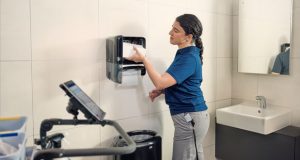Proper industrial hygiene is key to maintaining a healthy and productive workforce. This means effectively identifying, evaluating and controlling environmental stressors in the workplace.
Businesses should approach industrial cleanliness proactively, producing dedicated health and safety and hygiene standards, anticipating hazards before they occur and outlining the internal protocol for how to deal with harmful substances.
In this article, Anh-Tai Vuong, President, DuroVac discuss some of the key risks in industrial cleanliness and how businesses can establish safe foundations to prevent them from happening.
Identifying the dangers
The first step to ensure professional hygiene standards are adequate in the workplace is understanding and identifying all potential risks. These will vary dependent on workplace and environment and it may require a certified health and safety professional or industrial hygienist to assess the surroundings.
For example; businesses using heavy-duty machinery, like those in the manufacturing sector, there is a risk of polluting indoor air quality with fine dust or gasses. These can be difficult to spot with the naked eye and may leave employees with symptoms such as chronic coughs, nausea and occupational asthma.
Similarly, laboratory workers risk exposure to mould, fumes, radiation and even hazardous chemicals such as pesticides. When not properly controlled, this exposure causes respiratory problems and skin irritation.
Other industrial hygiene risks include exposure to constant loud noises, which typically impacts construction and manufacturing workers. And, extremes of temperature may affect those in warehouses or working outside. Even ergonomic hazards can impact those in everyday office jobs who sit for long periods.
Digging deeper
Employers should conduct a thorough risk assessment of any setting employees are expected to spend a significant amount of time. Risk assessments include a review of all physical, mental chemical or biological hazards present in all working environments.
However, it’s not enough to complete a one-off assessment. Regular reviews should be scheduled to check health and safety standards are being maintained, especially in workplaces containing heavy-duty machinery and equipment.
An initial risk assessment will reveal the hazards currently facing your workforce and provide the basis for subsequent assessments, reviewing each risk in further detail and outlining clear company policies for monitoring and dealing with each substance.
 This initial review may be a COSHH assessment, carried out by a health and safety expert, examining the workplace and daily work processes to highlight any environments or activities that may pose risks to those working on the ground day to day.
This initial review may be a COSHH assessment, carried out by a health and safety expert, examining the workplace and daily work processes to highlight any environments or activities that may pose risks to those working on the ground day to day.
Businesses should then schedule regular inspection reports, with the frequency depending on the nature of the job. Risk assessments should be reviewed at least annually to account for any changes in working patterns and reassess the environment, however some workplaces, like laboratories, may even call for weekly or daily inspections to ensure maximum hygiene standards.
Putting safe practices in place
The results of workplace assessments will inform the health and safety decisions you make for employees.
Firstly, for each hazard identified in your risk assessment, you should create a safety data sheet containing every detail, including how to spot it, possible symptoms and a clearly outlined policy for dealing with and removing the hazard.
Tackle each risk individually with the relevant hygienic tools. There’s no generic cleaning solution that deals with every hazard in a whole warehouse or workspace.
For warehouses and factories threatened by problems with dust or gases, steps must be taken to remove harmful particles and fully ventilate the workplace. Large spaces may require an industrial vacuum with HEPA filter, which removes heavy-duty dust spills and locks in particles so they can’t escape back into the air.
Adjustments should also be made to the workplace to ensure adequate ventilation, including industrial fans or local exhaust ventilation (LEV), which extracts airborne particles and disperses dangerously high concentrations of particles.
In laboratories and workplaces where employees are expected to handle potentially harmful particles or chemicals, safety features should include personal protective equipment (PPE) to protect against interaction with the skin, like protective eyewear, gloves and long-sleeved clothing.
Employers should also label workplaces with general health and safety advice. This may include labelling any wash stations and encouraging staff to wash their hands after handling substances.
Many businesses will also have their facilities regularly cleaned to an industrial standard, beyond daily or weekly dusting jobs. This may require a vacuum truck or the use of floor sweepers or scrubbers to remove dust and stains from warehouse floors.
There needs to be a clear protocol in place for those operating industrial machinery. Portable industrial vacuums, floor sweepers and other large, heavy-duty equipment must be afforded space and given a clear path to follow.
Define clear guides for these cleaning tasks, including routes around the warehouse that minimise disruption and eliminate any chance of collisions. Ensure all fire exits remain clear at all times and check for ergonomic risks such as tools or wiring left out that could provide a tripping or mechanical problem. It may be best to schedule this activity outside of typical working hours, but this isn’t an alternative to ensuring safety standards are met.
Training tips
The key to maintaining health and safety standards is getting buy-in from knowledgeable and trained staff. Employees responsible for maintaining safety standards will benefit from regular training sessions and clearly outlined company policies.
Make it easy for all workers – both health and safety professionals and other staff – to adhere to health and safety processes by labelling all materials and including information about strength, ingredients and steps to take in case of misuse.
Make logbooks containing details on how to handle, transport and store all materials available in every warehouse, factory or facility, so employees can ensure best practices.
Staff will already be balancing stressful and time-sensitive roles and adding additional health and safety processes may not be top of their list. However, you must get all employees on board with the importance of meeting health standards.
Start by pointing employees towards their designated health and safety professional who they can speak to for advice. Make it easy for all employees to access training by offering different platforms to suit everyone. Provide digital health and safety training for those who like this style and schedule talks from health and safety professionals for those who prefer a more face-to-face approach.
Complete timetable assessments at every stage of the health and safety process, from identifying hazardous substances to carefully disposing of them in an emergency. Offer rewards for those who consistently meet company standards and offer additional support and training for those who do not.
 Anh-Tai Vuong is president, corporate sales and business development, at DuroVac, a manufacturer of industrial vacuums designed for rugged applications.
Anh-Tai Vuong is president, corporate sales and business development, at DuroVac, a manufacturer of industrial vacuums designed for rugged applications.
With a Bachelor of Engineering from McGill University, Vuong has worked in industrial sales his entire professional life.
He specialises in aluminium smelters (primary metals), potash and fertilisers (mining), steel mills and foundries (primary metals) and combustible dust.





